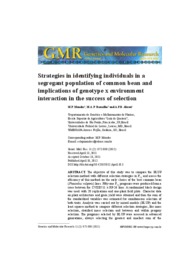Strategies in identifying individuals in a segregant population of common bean and implications of genotype x environment interaction in the success of selection.
Strategies in identifying individuals in a segregant population of common bean and implications of genotype x environment interaction in the success of selection.
Autoria: MENDES, M. P.; RAMALHO, M. A. P.; ABREU, A. de F. B.
Resumo: The objective of this study was to compare the BLUP selection method with different selection strategies in F2:4 and assess the efficiency of this method on the early choice of the best common bean (Phaseolus vulgaris) lines. Fifty-one F2:4 progenies were produced from a cross between the CVIII8511 x RP-26 lines. A randomized block design was used with 20 replications and one-plant field plots. Character data on plant architecture and grain yield were obtained and then the sum of the standardized variables was estimated for simultaneous selection of both traits. Analysis was carried out by mixed models (BLUP) and the least squares method to compare different selection strategies, like mass selection, stratified mass selection and between and within progeny selection. The progenies selected by BLUP were assessed in advanced generations, always selecting the greatest and smallest sum of the standardized variables. Analyses by the least squares method and BLUP procedure ranked the progenies in the same way. The coincidence of the individuals identified by BLUP and between and within progeny selection was high and of the greatest magnitude when BLUP was compared with mass selection. Although BLUP is the best estimator of genotypic value, its efficiency in the response to long term selection is not different from any of the other methods, because it is also unable to predict the future effect of the progenies x environments interaction. It was inferred that selection success will always depend on the most accurate possible progeny assessment and using alternatives to reduce the progenies x environments interaction effect.
Ano de publicação: 2012
Tipo de publicação: Artigo de periódico
Unidade: Embrapa Arroz e Feijão
Palavras-chave: Feijão, Melhoramento genético vegetal, Phaseolus vulgaris, Seleção genética
Observações
1 - Por padrão são exibidas publicações dos últimos 20 anos. Para encontrar publicações mais antigas, configure o filtro ano de publicação, colocando o ano a partir do qual você deseja encontrar publicações. O filtro está na coluna da esquerda na busca acima.
2 - Para ler algumas publicações da Embrapa (apenas as que estão em formato ePub), é necessário ter, no celular ou computador, um desses softwares gratuitos. Sistemas Android: Google Play Livros; IOS: iBooks; Windows e Linux: software Calibre.
Acesse outras publicações
Acesse a Base de Dados da Pesquisa Agropecuária (BDPA) para consultar o acervo completo das bibliotecas da Embrapa.

